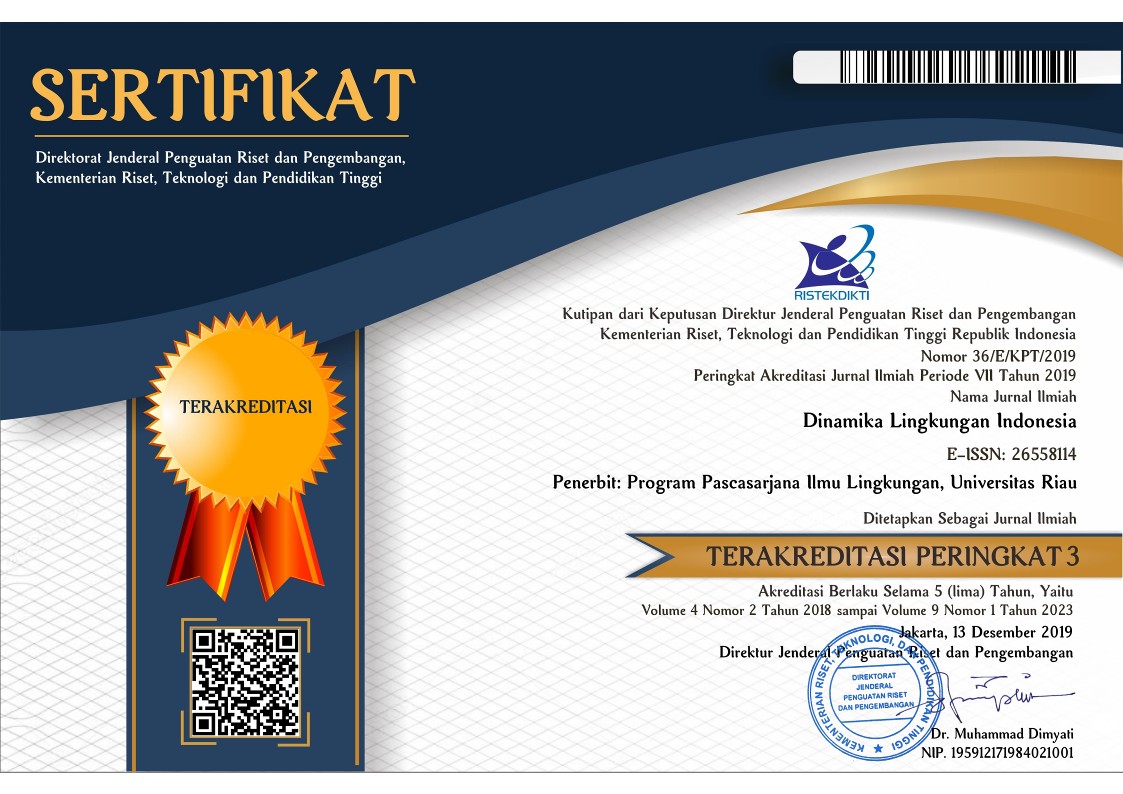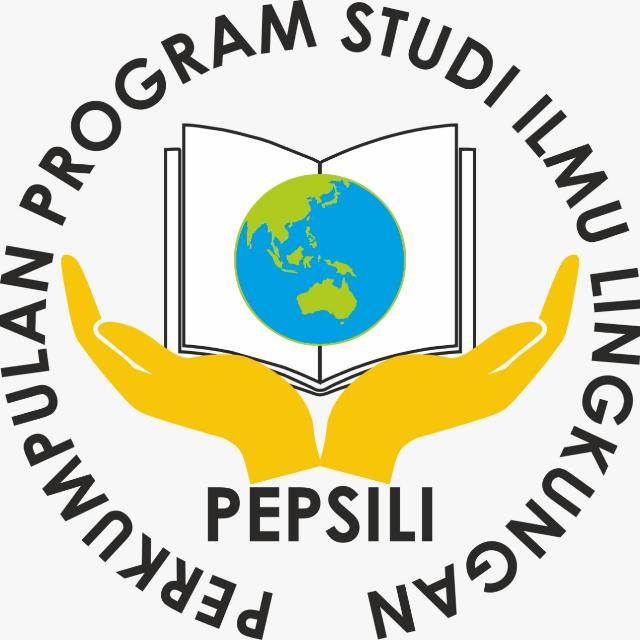Studi Fitoremediasi Merkuri Pada Tailing Amalgamasi Penambangan Emas Rakyat Menggunakan Akar Wangi (Vetiveria zizanioides L.)
Abstract
Heavy metal pollution in the soil has become a global problem along with the industrialization process, mining, and laboratory activities, as well as daily activities. Artisanal and small-scale gold mining (ASGM) activities using amalgamation methods have the potential to pollute the environment because they produce tailings with mercury (Hg) metal content, which causes various environmental problems even though they are in very low concentrations. The purpose of this study was to determine the characteristics of tailings polluted with Hg metal, determine Hg levels in soils that have been absorbed by Vetiveria zizanioides, determine the effect of compost addition on soil quality improvement, and determine the factor of mercury transfer from soil to plants. The results showed that the mercury concentration in amalgamation tailings of 201.6 mg/kg may decrease after 28 days of remediation to 13.72 mg/kg at TTG1, 170.73 mg/kg at TTG2, and 53.4 mg/kg at TTG3. The ability of Vetiveria zizanioides L. to absorb mercury in amalgamated tailings without adding compost can be seen from the TTG1 transfer factor value of 9.69.
Keywords
Full Text:
PDFReferences
Alì, H., Khan, E., & Sajad, M. A. (2013). Phytoremediation of heavy metals - Concepts and applications. Chemosphere, 91.
Anugroho, F., Kurniati, E., & Effendi, B. A. P. (2020). Potensi Fitoremediasi Tanah Tercemar Timbal (Pb) Dengan Penambahan EDTA Menggunakan Rumput Raja (Pennisetum purpuroides). Jurnal Sumberdaya Alam Dan Lingkungan, 7(1), 1–8. https://doi.org/10.21776/ub.jsal.2020.007.01.1.
Arisusanti, R. J., & Purwani, K. I. (2013). Pengaruh mikoriza Glomus fasciculatum terhadap akumulasi logam timbal (Pb) pada tanaman Dahlia pinnata. Jurnal Sains Dan Seni ITS, 2(2).
Borolla, S. M., Mariwy, A., & Manuhutu, J. (2019). Fitoremediasi Tanah Tercemar Logam Berat Merkuri (Hg) Menggunakan Tumbuhan Kersen (Muntingia Calabua L) dengan Sistem Reaktor. Molluca Journal of Chemistry Education (MJoCE), 9(2),78-89. https://doi.org/10.30598/mjocevol9iss2pp78-89.
Chen, X. W., Wong, J. T. F., Wang, J. J., & Wong, M. H. (2021). Vetiver grass-microbe interactions for soil remediation. Critical Reviews in Environmental Science and Technology, 51(9), 897–938. https://doi.org/10.1080/10643389.2020.1738193.
Cristaldi, A., Conti, G. O., Jho, E. H., Zuccarello, P., Grasso, A., Copat, C., & Ferrante, M. (2017). Phytoremediation of contaminated soils by heavy metals and PAHs. A brief review. Environmental Technology and Innovation, 8, 309–326. https://doi.org/10.1016/j.eti.2017.08.002.
Dadashi, S., Sepanlou, M. G., & Mirnia, S. K. (2019). Influence organic compost compounds on soil chemical and physical properties. International Journal of Human Capital in Urban Management, 4(1).
Eckley, C. S., Blanchard, P., McLennan, D., Mintz, R., & Sekela, M. (2015). Soil-Air Mercury Flux near a Large Industrial Emission Source before and after Closure (Flin Flon, Manitoba, Canada). EnvirEnvironmental Science & Technologyon Sci Technol, 49(16).
Eckley, C. S., Parsons, M. T., Mintz, R., Lapalme, M., Mazur, M., Tordon, R., … St Louis, V. (2013). . Impact of closing Canada’s largest point-source of mercury emissions on local atmospheric mercury concentrations. Environmental Science & Technology, 47(18).
Hidayati, N., Tit, J., & Fauzia, S. (2009). Mercury and Cyanide Contaminations in Gold Mine Environment and Possible Solution of Cleaning Up by Using Phytoextraction. HAYATI Journal of Biosciences, 16(3), 88–94.
Irawanto, R. (2010). Fitoremediasi Lingkungan dalam Tanaman Bali. UPT Balai Konserasi Tumbuhan Kebun Raya Purwodadi-LIPI, 2(4), 29–35.
Karamina, H., Fikrinda, W., & Murti, A. T. (2017). Kompleksitas pengaruh temperatur dan kelembaban tanah terhadap nilai pH tanah di perkebunan jambu biji varietas kristal (Psidium guajava l.) Bumiaji, Kota Batu. Kultivasi, 16(3), 430–434.
Kilikily, D., Mariwy, A., & Sunarti. (2020). Studi Akumulasi Logam Berat Merkuri (Hg) oleh Tanaman Trembesi (Samanea saman). Science Map Journal, 2(2), 85–89.
Kriti, Basant, N., Singh, J., Kumari, B., Sinam, G., Gautam, A., Mallick, S. (2021). Nickel and cadmium phytoextraction efficiencies of vetiver and lemongrass grown on Ni–Cd battery waste contaminated soil: A comparative study of linear and nonlinear models. Journal of Environmental Management, 295(June), 113144.
https://doi.org/10.1016/j.jenvman.2021.113144.
Kwiatkowska-Malina, J. (2018). Functions of organic matter in polluted soils: The effect of organic amendments on phytoavailability of heavy metals. Applied Soil Ecology, 123.
Lona, L. M., Linda, R., & Mukarlina. (2015). Pengaruh Logam Merkuri ( Hg ) Terhadap Pertumbuhan Seruni Rambat ( Wedelia trilobata L . Hitchc ). Protobiont, 4(3), 26–30.
Mangkoedihardjo, S., & Triastuti, Y. (2011). Vetiver in Phytoremediation of Mercury Polluted Soil with the Addition of Compost. Journal of Applied Sciences Research, 7(4), 465–469.
Mantey, J., Nyarko, K. B., Owusu-Nimo, F., Awua, K. A., Bempah, C. K., Amankwah, R. K., & Appiah-Effah, E. (2020). Mercury contamination of soil and water media from different illegal artisanal small-scale gold mining operations (galamsey). Heliyon, 6(6).
Mariwy, A., Dulanlebit, Y. H., & Yulianti, F. (2020). Studi Akumulasi Logam Berat Merkuri menggunakan Tanaman Awar-Awar (Ficus Septica Burm F). Indo. J. Chem. Res, 2020, 7(2), 159-169 STUDI, 7(2), 159–169.
Meilianto, W. D., Indrasari, W., & Budi, E. (2022). Karakterisasi Sensor Suhu Dan Kelembaban Tanah untuk Aplikasi Pengukuran Kualitas Tanah. Prosiding Seminar Nasional Fisika, 10, 117–122.
Ng, C. C., Boyce, A. N., Abas, M. R., Mahmood, N. Z., & Han, F. (2019). Phytoassessment of Vetiver grass enhanced with EDTA soil amendment grown in single and mixed heavy metal–contaminted soil. Environmental Monitoring and Assessment, 191(7). https://doi.org/10.1007/s10661-019-7573-2.
Nurfatini, B., & Amir, S. (2018). Recent Advances in Mercury Detection; Towards Enabling a Sensitive and Rapid Point-of-Check Measurement. Journal of Toxicology and Risk Assessment, 4(1), 1–10. https://doi.org/10.23937/2572-4061.1510010
Palar, H. (2008). Pencemaran dan Toksikologi Logam Berat. Jakarta: PT. Rineka Cipta.
Patandungan, A., Syamsidar, H., & Aisyah. (2016). Fitoremediasi Tanaman Akar Wangi (Vetiver zizanioides) terhadap Tanah Tercemar Logam Kadmium (Cd) pada Lahan TPA Tamangapa Antang Makassar. Al-Kimia, 4(2), 8–21.
Prawira, R., Syekhfani, & Kusumarini, N. (2018). Pengaruh Pemberian Amonium Tiosulfat dan Kompos Terhadap Serapan Emas (Au) Tanaman Akar Wangi (Vetivera zizanioides) pada Tailing Jampang Kulon Kabupaten Sukabumi Jawa Barat. Jurnal Tanah Dan Sumberdaya Lahan, 5(2), 911–919.
Priherdityo, E., Susanto, S., & Chadirin, Y. (2016). Pengaturan Intensitas Larutan Hara terhadap Pertumbuhan Tanaman Akar Wangi (Vetiveria zizanioides L.) yang Dibudidayakan Secara Aeroponik. Bul. Agrohorti, 4(1), 104–112.
Puspita, A. D., Santoso, A., & Yulianto, B. (2014). Studi akumulasi logam timbal (Pb) dan efeknya terhadap kandungan klorofil daun mangrove rhizophora mucronata. Journal of Marine Research, 3(1).
Ratnawati, R, & Faizah. (2020). Phytoremediation of Mercury Contaminated Soil with The Addition of Compost. J. Eng. Technol. Sci., 52(1), 66–80.
Ratnawati, Rhenny, & Fatmasari, R. D. (2018). Fitoremediasi Tanah Tercemar Logam Timbal (Pb) Menggunakan Tanaman Lidah Mertua (Sansevieria Trifasciata) dan Jengger Ayam (Celosia Plumosa). Al-Ard: Jurnal Teknik Lingkungan, 3(2), 62–69. https://doi.org/10.29080/alard.v3i2.333.
Raya, I., & Rahmah, R. (2012). The Bioaccumulation of Cd (ii) Ions on Euchema Cottoni Seaweed Bioakumulasi Ion Cd (ii) Pada Rumput Laut Euchema Cottoni. JICoR: Journal of Indonesian Coral Reefs, 13(2).
Rifaldi, Isrun, & Khaliq, M. A. (2022). Fitoremediasi Tanaman Bunga Matahari (Helianthus annus L.) dan Akar Wangi (Vetiveria zizanioides L.) dalam Mengikat Logam Berat Merkuri (Hg) pada Limbah Tailing Tambang Emas Paboya. E-J.Agrotekbis, 10(3), 132–139.
Rong, Q., Zhong, K., Huang, H., Li, C., Zhang, C., & Nong, X. (2020). Humic acid reduces the available cadmium, copper, lead, and zinc in soil and their uptake by tobacco. Applied Sciences, 10(3).
Rostwentivaivi, V., & Rellykur, K. (2018). Risiko Produktivitas Akar Wangi Di Kabupaten Garut. Jurnal Manajemen Agribisnis (Journal Of Agribusiness.
DOI: http://dx.doi.org/10.31258/dli.11.1.p.23-32
Refbacks
- There are currently no refbacks.

This work is licensed under a Creative Commons Attribution 4.0 International License.





